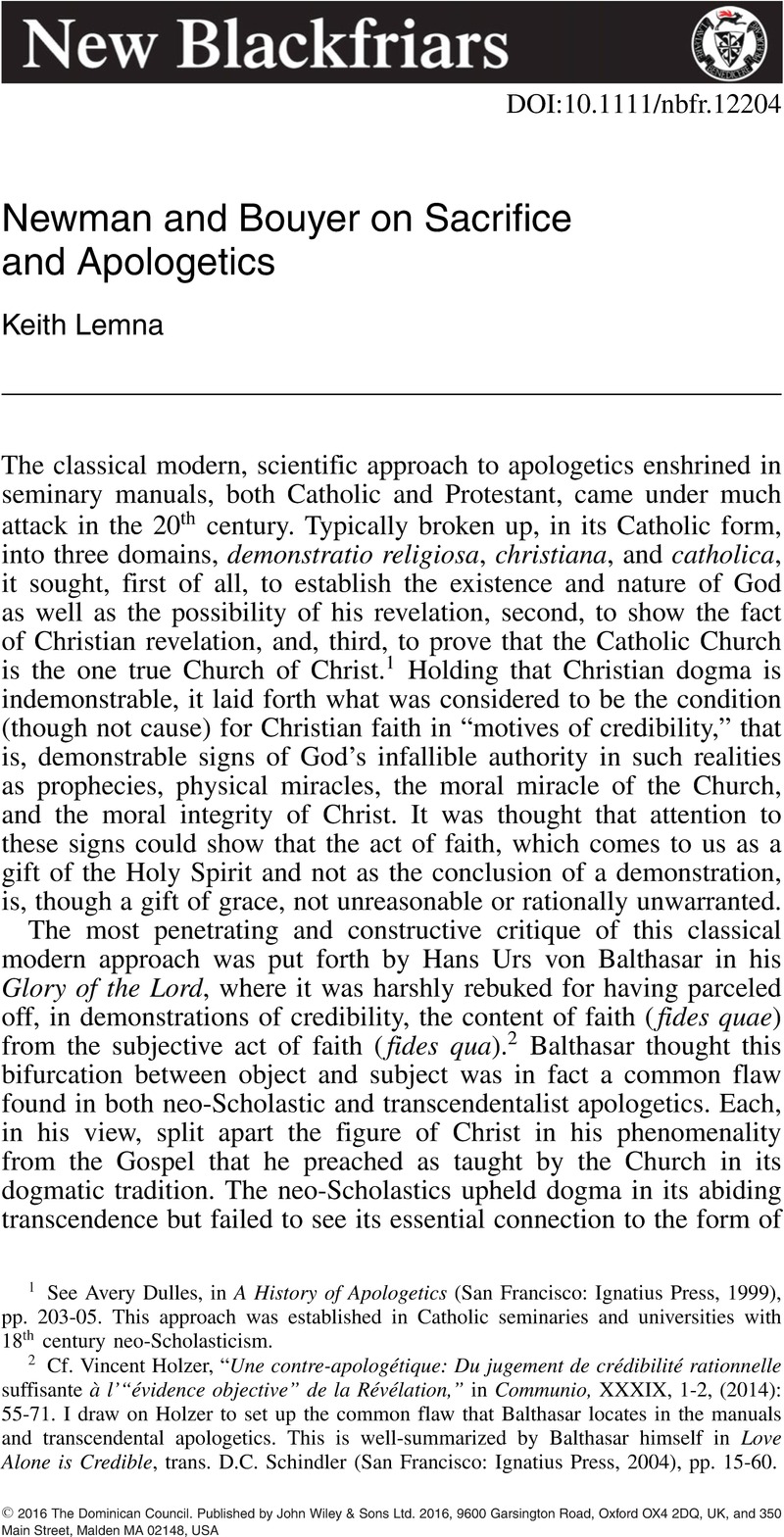No CrossRef data available.
Article contents
Newman and Bouyer on Sacrifice and Apologetics
Published online by Cambridge University Press: 01 January 2024
Abstract

- Type
- Original Article
- Information
- Copyright
- Copyright © 2016 The Dominican Council. Published by John Wiley & Sons Ltd
References
1 See Dulles, Avery, in A History of Apologetics (San Francisco: Ignatius Press, 1999), pp. 203-05Google Scholar. This approach was established in Catholic seminaries and universities with 18th century neo-Scholasticism.
2 Cf. Vincent Holzer, “Une contre-apologétique: Du jugement de crédibilité rationnelle suffisante à l’“évidence objective” de la Révélation,” in Communio, XXXIX, 1-2, (2014): 55-71. I draw on Holzer to set up the common flaw that Balthasar locates in the manuals and transcendental apologetics. This is well-summarized by Balthasar himself in Love Alone is Credible, trans. Schindler, D.C. (San Francisco: Ignatius Press, 2004), pp. 15-60Google Scholar.
3 Cf. Nichols, Aidan, The Word Has Been Abroad: A Guide Through Balthsar's Aesthetics (Washington, D.C.: The Catholic University of America Press, 1998), pp. 27-33Google Scholar.
4 Cf. Lacoste, Jean-Yves, From Theology to Theological Thinking, trans. Hackett, W. Chris (Charlottesville, VA: University of Virginia Press, 2014), pp. 86-7Google Scholar.
5 Newman, , Apologia Pro Vita Sua, Norton Critical Edition (New York: W.W. Norton & Company, 1968), p. 34Google Scholar.
6 Ibid., p. 21.
7 Newman, , An Essay in Aid of a Grammar of Assent (Notre Dame Press, 1979), p. 300Google Scholar.
8 Ibid., pp. 302-3.
9 Ibid., p. 303.
10 This expression is taken from Bouyer who understands it in the phenomenological sense meant by Husserl. See Bouyer, , The Invisible Father, trans. Gilbert, Hugh (Petersham, MA: St. Bede's Publications, 1999), p. 7Google Scholar.
11 Bouyer, , Cosmos: The World and the Glory of God, trans. Fontnouvelle, Pierre de (Petersham, MA : St. Bede's Publications, 1988), p. 205Google Scholar.
12 Newman, A Grammar of Assent, p. 316. The quotation is taken from Butler's Analogy, II, p. 5.
13 Grammar of Assent, p. 376.
14 Bouyer, , Newman: A Spiritual Biography (San Francisco: Ignatius Press, 2011)Google Scholar. First published in Paris in 1952.
15 See The Invisible Father, all of part one.
16 Ibid., p. 8.
17 Ibid., pp. 129-30.
18 Ibid., pp. 130-1.
19 Ibid., p. 131.
20 Ibid.
21 Ibid.
22 Bouyer, , The Eternal Son, trans. Sr.Inkel, Simone and Loughlin, John F. (Huntington, Indiana: Our Sunday Visitor Press, 1978), p. 126Google Scholar.
23 Ibid., p. 127.
24 The Eternal Son, p. 128
25 Ibid.
26 Bouyer, , Rite and Man: Natural Sacredness and Christian Liturgy, trans. Costelloe, M. Joseph S.J. (Notre Dame University Press, 1963), p. 121Google Scholar.
27 The Invisible Father, pp. 66-74.
28 Ibid., p. 70.
29 Ibid., p. 73.




